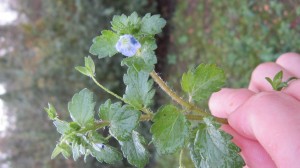Speedwells ‘sisters’ on Whiteknights campus: spot the difference?
As many as ten different species of speedwells (Veronica, in the family Veronicaceae) have been recorded on the Whiteknights campus, and two of them are the slender speedwell (Veronica filiformis) and bird’s eye speedwell (Veronica persica). These two speedwell ‘sisters’ have a number features that distinguish them despite their general similarity.
Veronica filiformis, commonly called slender, threadstick or round-leaved speedwell, is a perennial species of lawns and was introduced from turkey as a rock garden plant in the early 1800s and has since ‘esc aped’ and is now well established in lawns and roadsides and increasing throughout Britain (Clapham et al 1989). The leaves are characteristically rounded or kidney shaped, bluntly toothed, stalked and pinnately veined. The flower is pale blue, zygomorphic, with four unequal lobes and arising singly from leaf axils on long stalks (pedicels). It is self-sterile, rarely setting seed and producing capsules in the UK, instead it spreads rapidly by means of its creeping, minutely hairy stems (stolons) rooting at the nodes.
Veronica persica, commonly called field or winter speedwell, is a native of Eurasia and was first recorded in Britain in 1825. A winter annual, it establishes readily from seed in disturbed and cultivated ground. The flower is bright blue, the lower lobe often paler or white and produced singly on long pedicels. The capsule has two strongly divergent lobes looking heart-shaped or cordate. The procumbent stem is conspicuously hairy and branched and the leaves are ovate and short-stalked.
These ‘sisters’ of the Veronicaceae clearly share similar features; the creeping habit, the solitary zygomorphic flowers displayed singly on long pedicels, the hairy stem, the short-stalked leaves, and, coincidentally both having arrived in Britain at almost the same time. However close observation soon reveals the distinguishing features. V. persica is much more hairy and is an annual plant unlike V. filiformis which is perennial. V persica produces abundant capsules and seed while V. filiformis reproduces only asexually (in Britain at least). V persica also has alternate leaves on the upper stem and grows taller than V. filiformis, the flower colour of both also differs slightly as does the preferred habitat. Sisters of the same family for sure, but different enough to make them more distant relations than first appears.
Photographs of Veronica species taken by the author of plants on campus.




Very interesting i will be looking around on campus for these two!